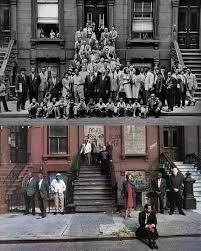In the summer of 1958, a young photographer named Art Kane conceived an idea that seemed nearly beyond belief: gather together all the greatest jazz musicians in America for a single photograph. He envisioned a moment in time where legends would mingle— not in a concert hall or backstage, but simply on a Harlem sidewalk. It was a daunting plan, but somehow, Kane made it happen.
On that morning, 57 of the most influential jazz artists of the day showed up. Count Basie, Thelonious Monk, Dizzy Gillespie, Sonny Rollins—all icons, each with their own story, style, voice. They stood side by side, but the image captured much more than a lineup. Rather than formal, stiff poses, they laughed, leaned on one another, shared jokes. The energy felt spontaneous. To look at that photograph is to see the very heart of jazz: improvisation, connection, humanity.
That photograph came to be known simply as “A Great Day in Harlem.” It endures not just because of who was in it, but because of what it symbolizes. At its core: community. So many artists who defined sounds, broke boundaries, lived hard lives, but also shared deep love for the art. This was more than a photo—it was a moment of unity, celebration, and history captured.

Fast forward to 1996. Nearly forty years later, some of the survivors of that original gathering returned to the same block in Harlem. The brownstones still stood, the sidewalk still there, the very same spot that had witnessed history. The spirit too, though faint with time, was recognizably alive. But many faces were missing—gone forever into memory and story. The music lives on; the people do not always. It was both a reunion and a remembrance.
Looking at the original photo beside its later version is to confront time itself. People change. People leave. But what they build—the artistic expressions, the laughter, the friendships—those things linger. The people in that famous 1958 photo are not just individuals; they’re symbols of creativity’s timeless power. Their work reverberates beyond their lifespans. Their contributions serve as reminders that amidst loss, there is something lasting.
Today, fifty, sixty, seventy years on, most of us will also be gone. But for this moment—and every moment available—that life is happening. Let’s forgive. Let’s embrace. Let’s create. Let’s connect. Because though moments fade, their echoes can fill decades, centuries, perhaps even lifetimes.